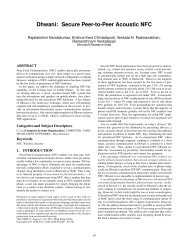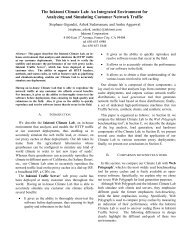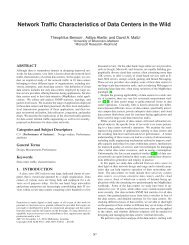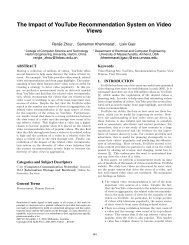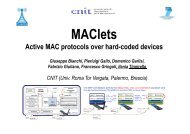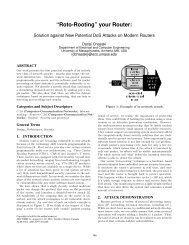ICTCP: Incast Congestion Control for TCP in Data Center ... - Sigcomm
ICTCP: Incast Congestion Control for TCP in Data Center ... - Sigcomm
ICTCP: Incast Congestion Control for TCP in Data Center ... - Sigcomm
You also want an ePaper? Increase the reach of your titles
YUMPU automatically turns print PDFs into web optimized ePapers that Google loves.
loss, while they focus on how to mitigate the impact<br />
of packet loss, either less frequent timeouts or faster<br />
retransmission on timeouts. This makes our work complementary<br />
to previous work.<br />
Motivated by the <strong>in</strong>teraction between short flows that<br />
require short-latency and long background throughputoriented<br />
flows, DC<strong>TCP</strong> [2] focuses on reduc<strong>in</strong>g the Ethernet<br />
switch buffer occupation. In DC<strong>TCP</strong>, ECN with<br />
thresholds modified is used <strong>for</strong> congestion notification,<br />
while both <strong>TCP</strong> sender and receiver are slightly modified<br />
<strong>for</strong> a novel f<strong>in</strong>e gra<strong>in</strong>ed congestion w<strong>in</strong>dow adjustment.<br />
Reduced switch buffer occupation can effectively<br />
mitigate potential overflow caused by <strong>in</strong>cast.<br />
Their experimental results show that DC<strong>TCP</strong> outper<strong>for</strong>ms<br />
<strong>TCP</strong> <strong>for</strong> <strong>TCP</strong> <strong>in</strong>cast, but eventually converges to<br />
equivalent per<strong>for</strong>mance as <strong>in</strong>cast degree <strong>in</strong>creases, e.g.,<br />
over 35 senders. The difference between <strong>IC<strong>TCP</strong></strong> and<br />
DC<strong>TCP</strong> is that <strong>IC<strong>TCP</strong></strong> only touches <strong>TCP</strong> receiver, and<br />
<strong>IC<strong>TCP</strong></strong> uses the throughput <strong>in</strong>crease estimation to predict<br />
whether available bandwidth is enough <strong>for</strong> receive<br />
w<strong>in</strong>dow <strong>in</strong>crease, and avoids congestion effectively.<br />
To avoid congestion, <strong>TCP</strong> Vegas[3] has been proposed.<br />
In <strong>TCP</strong> Vegas, sender adjusts congestion w<strong>in</strong>dow<br />
based on the difference of expected throughput<br />
and actual throughput. However, there are several issues<br />
to apply <strong>TCP</strong> Vegas directly to a receiver w<strong>in</strong>dow<br />
based congestion control <strong>in</strong> high-bandwidth low-latency<br />
network: 1) As we have shown <strong>in</strong> Figure 3, the RTT<br />
is only hundreds of microseconds, and RTT <strong>in</strong>creases<br />
be<strong>for</strong>e available bandwidth is reached. The w<strong>in</strong>dow<br />
adjustment <strong>in</strong> Vegas is based on a stable base RTT,<br />
which makes Vegas may over-estimate throughput. 2)<br />
In Vegas, the absolute difference of expected and actual<br />
throughput is used. While it changes greatly, as queue<strong>in</strong>g<br />
latency (also at hundreds of microseconds scale)<br />
greatly affects the sample of RTT. This makes the absolute<br />
difference def<strong>in</strong>ed <strong>in</strong> Vegas hard to use <strong>for</strong> w<strong>in</strong>dow<br />
adjustment, and also this is the reason we use the ratio<br />
of throughput difference over expected throughput.<br />
<strong>TCP</strong> receiver buffer [14], receive w<strong>in</strong>dow and also delayed<br />
ACK [11] are used to control the bandwidth shar<strong>in</strong>g<br />
between multiple <strong>TCP</strong> flows at receive side. In the<br />
previous work, they focus on the ratio of achieved bandwidth<br />
of those multiple <strong>in</strong>dependent <strong>TCP</strong> flows. While<br />
our focus is congestion avoidance to prevent packet loss<br />
<strong>in</strong> <strong>in</strong>cast, which is not considered <strong>in</strong> previous work.<br />
Meanwhile, <strong>IC<strong>TCP</strong></strong> adjusts receive w<strong>in</strong>dow <strong>for</strong> better<br />
fairness among multiple <strong>TCP</strong> flows only when available<br />
bandwidth is small.<br />
9. CONCLUSIONS<br />
In this paper, we have presented the design, implementation,<br />
and evaluation of <strong>IC<strong>TCP</strong></strong>, to improve <strong>TCP</strong><br />
per<strong>for</strong>mance <strong>for</strong> <strong>TCP</strong> <strong>in</strong>cast <strong>in</strong> data center networks.<br />
Different from previous approaches by us<strong>in</strong>g a f<strong>in</strong>e tuned<br />
timer <strong>for</strong> faster retransmission, we focus on receiver<br />
based congestion control algorithm to prevent packet<br />
loss. <strong>IC<strong>TCP</strong></strong> adaptively adjusts <strong>TCP</strong> receive w<strong>in</strong>dow<br />
based on the ratio of difference of achieved and expected<br />
per connection throughputs over expected ones, as well<br />
as the last-hop available bandwidth to the receiver.<br />
We have developed a light-weighted, high per<strong>for</strong>mance<br />
W<strong>in</strong>dow NDIS filter driver to implement <strong>IC<strong>TCP</strong></strong>. Compared<br />
with directly implement<strong>in</strong>g <strong>IC<strong>TCP</strong></strong> as part of the<br />
<strong>TCP</strong> stack, our driver implementation can directly support<br />
virtual mach<strong>in</strong>es, which are becom<strong>in</strong>g prevail <strong>in</strong><br />
data centers. We have built a testbed with 47 servers<br />
together with a 48-port Ethernet Gigabit switch. Our<br />
experimental results demonstrate that <strong>IC<strong>TCP</strong></strong> is effective<br />
to avoid congestion by achiev<strong>in</strong>g almost zero timeout<br />
<strong>for</strong> <strong>TCP</strong> <strong>in</strong>cast, and it provides high per<strong>for</strong>mance<br />
and fairness among compet<strong>in</strong>g flows.<br />
10. REFERENCES<br />
[1] M. Al-Fares, A. Loukissas, and A. Vahdat. A Scalable,<br />
Commodity <strong>Data</strong> <strong>Center</strong> Network Architecture. In Proc.<br />
SIGCOMM, 2008.<br />
[2] M. Alizadeh, A. Greenberg, D. Maltz, J. Padhye, P. Patel,<br />
B. Prabhakar, S. Sengupta, and M. Sridharan. DC<strong>TCP</strong>:<br />
Efficient Packet Transport <strong>for</strong> the Commoditized <strong>Data</strong><br />
<strong>Center</strong>. In Proc. SIGCOMM, 2010.<br />
[3] L. Brakmo and L. Peterson. <strong>TCP</strong> Vegas: End to End<br />
<strong>Congestion</strong> Avoidance on a Global Internet. JSAC, 1995.<br />
[4] Y. Chen, R. Griffith, J. Liu, R. Katz, and A. Joseph.<br />
Understand<strong>in</strong>g <strong>TCP</strong> <strong>Incast</strong> Throughput Collapse <strong>in</strong><br />
<strong>Data</strong>center Networks. In Proc. WREN, 2009.<br />
[5] J. Dean and S. Ghemawat. MapReduce: Simplified <strong>Data</strong><br />
Process<strong>in</strong>g on Large Clusters. In OSDI’04, 2004.<br />
[6] C. Guo, G. Lu, D. Li, H. Wu, X. Zhang, Y. Shi, C. Tian,<br />
Y. Zhang, and S. Lu. BCube: A High Per<strong>for</strong>mance,<br />
Server-centric Network Architecture <strong>for</strong> Modular <strong>Data</strong><br />
<strong>Center</strong>s. In Proc. SIGCOMM, 2009.<br />
[7] C. Guo, H. Wu, K. Tan, L. Shi, Y. Zhang, and S. Lu.<br />
DCell: A Scalable and Fault Tolerant Network Structure<br />
<strong>for</strong> <strong>Data</strong> <strong>Center</strong>s. In Proc. SIGCOMM, 2008.<br />
[8] V. Jacobson, R. Braden, and D. Borman. <strong>TCP</strong> Extensions<br />
<strong>for</strong> High Per<strong>for</strong>mance. RFC1323, May 1992.<br />
[9] S. Kandula, S. Sengupta, A. Greenberg, P. Patel, and<br />
R. Chaiken. The Nature of <strong>Data</strong>center Traffic:<br />
Measurements & Analysis. In Proc. IMC, 2009.<br />
[10] E. Krevat, V. Vasudevan, A. Phanishayee, D. Andersen,<br />
G. Ganger, G. Gibson, and S. Seshan. On Application-level<br />
Approaches to Avoid<strong>in</strong>g <strong>TCP</strong> Throughput Collapse <strong>in</strong><br />
Cluster-based Storage Systems. In Proc. Supercomput<strong>in</strong>g,<br />
2007.<br />
[11] P. Mehra, A. Zakhor, and C. Vleeschouwer. Receiver-driven<br />
bandwidth shar<strong>in</strong>g <strong>for</strong> <strong>TCP</strong>. In Proc. INFOCOM, 2003.<br />
[12] D. Nagle, D. Serenyi, and A. Matthews. The Panasas<br />
ActiveScale Storage Cluster: Deliver<strong>in</strong>g scalable high<br />
bandwidth storage. In Proc. SC, 2004.<br />
[13] A. Phanishayee, E. Krevat, V. Vasudevan, D. Andersen,<br />
G. Ganger, G. Gibson, and S. Seshan. Measurement and<br />
Analysis of <strong>TCP</strong> Throughput Collapse <strong>in</strong> Cluster-based<br />
Storage Systems. In Proc. USENIX FAST, 2008.<br />
[14] N. Spr<strong>in</strong>g, M. Chesire, M. Berryman, and<br />
V. Sahasranaman. Receiver Based Management of Low<br />
Bandwidth Access L<strong>in</strong>ks. In Proc. INFOCOM, 2000.<br />
[15] V. Vasudevan, A. Phanishayee, H. Shah, E. Krevat,<br />
D. Andersen, G. Ganger, G. Gibson, and B. Mueller. Safe<br />
and Effective F<strong>in</strong>e-gra<strong>in</strong>ed <strong>TCP</strong> Retransmissions <strong>for</strong><br />
<strong>Data</strong>center Communication. In Proc. SIGCOMM, 2009.



